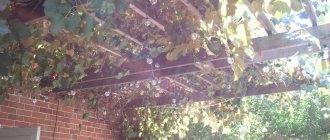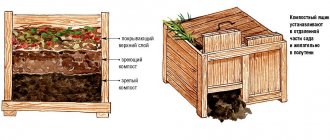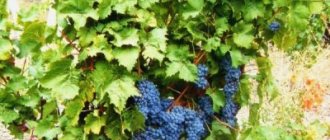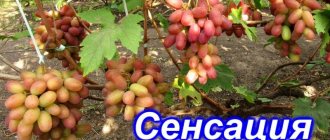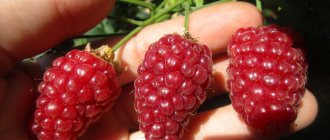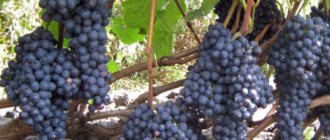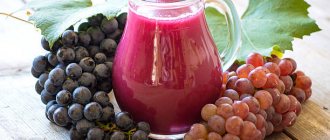Crimean technical grape varieties have many varieties. Among them, Citron Magaracha stands out, loved by winegrowers for its stable yield and unpretentiousness.
The berries produce excellent table and dessert wine, with an original taste and aroma. The variety is mainly cultivated in the southern regions, but gardeners in the middle zone also successfully grow Magaracha.
Description of the variety
Citronny was bred by scientists of the Magarach Research Institute (Crimea), and has been registered in the variety register since 2004. Recommended for use in winemaking (technical processing).
The parent couple is early Madeleine Angevin and Novoukrainsky. In terms of harvest time, the berries turned out to be a mid-season variety, the main purpose is the preparation of dessert and table wines, champagne.
The young vine is green, mature shoots acquire a brown and dark red color. The growth vigor is high, the bush grows quickly, so you need to immediately take care of the trellises.
The leaf blades are three-lobed, with a smooth surface, without pubescence. In the area of the pink petiole there is an open and heavily incised notch. The color of the leaves is bright green. The flowers are bisexual. Citron Magaracha does not need pollinator replanting.
Numerous creations of the Magarach Institute
The centuries-old experience of Crimean winegrowers is translated into new vine varieties by employees of the department of grape selection and genetics of the Magarach Institute. This work has been carried out since the creation of the scientific institution. Nowadays, in Moldova, Ukraine, Russia, Azerbaijan, and Kazakhstan, vines of the third generation of grapes are growing, having group resistance to the negative effects of the environment. Many of them have names that sound like the name of the institute: Gift of Magarach, Firstborn of Magarach, Centaur of Magarach, Antey of Magarach, Tavkveri of Magarach, Ruby Magarach, Bastardo of Magarach and others. In total, there are two and a half dozen such names in the list of varieties of the ampelographic collection of the institute; among the synonymous names there are even more of them.
The centuries-old experience of Crimean winegrowers is embodied in new vine varieties by employees of the department of grape selection and genetics of the Magarach Institute.
Description of fruits
The clusters are elongated, conical in shape. The length reaches 18-22 cm. Usually several wings are formed. Standard weight is 250-270 grams, some specimens grow up to 320-350 grams.
Round berries with thin but tough skin. The color is golden, when ripe it is yellow-amber. 3-4 seeds are formed in the dense pulp. The weight of the berries is 3-4 grams, the sugar content is 25-27%. Acid – 6-7 g/l.
The taste is pleasant, with a pronounced aroma of citrus and nutmeg.
On a note! Unlike many technical varieties, Citron is tasty when eaten fresh.
The ripening of the vines is stable, according to indicators - 85-90%. During the harvest period, 8-9 kg of berries are removed from an adult bush.
The variety is unpretentious, resistant to traditional diseases, is little affected by pests and is not attacked by wasps. Tolerates frosts down to -25ºC, but is most often grown as a cover crop.
The wine made from Magarachi has a refined floral-citrus aroma and a hint of nutmeg in the taste.
Grapes cultivated in Crimea gain standard sugar content. In other regions, sugar levels are lower. In the middle zone, Citron Magaracha is grown for blending with other grape varieties; in the south it is used as a mono-variety.
Wines made from berries are marked on the tasting scale as 7.8-7.9 points out of a total of 8 points. Citron Magaracha is the basis of wine brands that have been awarded prizes at international exhibitions. One of the famous brands: Muscatel White (1998), which has won awards at numerous winemaking competitions in different countries.
Forum statistics
207033 Messages in 1634 Topics from 5593 Users. Latest user: Amaya Latest message: “Ripening dates are different...” ( Today at 00:37:47 ) Latest messages on the forum.
Now on the forum
49 Guests, 7 Users
Users in the last 15 minutes: leonidych, zsb, vladimirM, yotmast, mers, Serg1707, SNovichek [Blocked] [Section Moderator] [Forum Moderator]
Maximum online today: 77 . All-time maximum online: 2758 (28 July 2021, 17:22:51)
Users who visited the forum in the last 24 hours
Total: 299
(Visible: 298, Hidden: 1) 1963, leonidych, zsb, vladimirM, yotmast, mers, Serg1707, SNovichek, hanter64, znakomij, Alexander K, Vardan, Sergey Fer, Anatoly Sivkov, Alexey V, Ilya 77, Andrey Gladilin, Tatyana A., Belgorodets, in Astrakhan, Oksana Kopp, Tatyana B, sem_en, Alex65, Vladimir 153, skier, Igor Viktorovich, slavalimon, Alexander Vl., Primorets, OlgaOs, SANYCH, 31rus, mystic69, DorontsovPeter, Andrey Tsvetkov, Buba, Cherkessk , igor222, Andrey76, Elena Z, vlad51, Kenig, Nikolay Rex, Sergey 1965, Vladimir Buturlakin, DSW, psv1960, Dmitry 77, Vasily V., Vyacheslav03, Natalia Nikolaevna, Sergey Tashchiyan, Nikolay S., Igor Sergeevich, alexsandr, kvg , Pioneer, Polyanina Ekaterina, nicson7, Elena Aleshchenko, Alexander-ask-34, Verona, Igor F., Taker, Tikhy, Henry, Yuri72, L.A.P., Gaivoronsky Yuri, Sergeevich, Sergey Chistokletov, Svetlana Streletskaya, Galinka , Alexey Deminov, Naumov Igor, Vyacheslav136, Gloomy, Katrin, AndSanych, Mikhno Alexander, Ded31, Filippov Oleg, Vladimir ++, Svetla777, Mikhail Alekseevich, Lydia58, Mikhail77, ALEXANDER BRYANSKY, Vladimir-kanevskaya, DIL, Amber7394, Marina Protasov a, TITOVA LYUBOV, Linx, alexander66, Natalya M, Mikhail Fesenko, ElenkaF, Amaya, Alexander71, Boris 1952, tsv, Maximilian, 25nata35, nadia, GALINA ANOKHINA, Igor_K, Alexander Kolesnikov, Ivan Levin, Pitko, weather forecaster, eSAa, cecet71, atseton , Alexander Smirnov, Vladimir Kostochkin, Vladimir Berdnikov, Gocha, pioneer-2, LeXa_KoT, Sergey 61, Sergey Yuryev, Erem, alexss, Evgeniy52, Skif, lomakin1969, Vladimir Kovba, dayton, Yuri Semyonov, N.A. Sokolov, Pavlentiy, Sa-shura, Volgogradka, Dmitry Anatolyevich, Grandfather Igor, Andrey Lis, Bublichenko Alexander M, Marina Krymskaya, stenlly2010, irahelm, Vyacheslav Vladimirovich, Vladimir Shilov, Aprel, Badaev Dmitry, gheo55, Yura, y_fed, rambo, Yagodka, Valentina Ivanovna, Kryn, oleg9f, DED2, Svetlana Korotina, Oleg Ivanovich delivered, Eduard., santra, L2k2m7n, Alexander48, Viknik, Andrey 31, m2d, Marshal, Valery Rastorguev, Soshnin Yura, Amateur gardener, Galina, Vasily1111, gardener, marlin64, Salex Sergei, Sergey Ko, Ramiz, Victor_, Kosmos, Potap05, Yuri 36, Vitaliysd, Inna161, Vova Kapran, Vladimir Shcherbinin, Valeri, Niy1, Cfibr, Andrey68, Elvira 2017, Kulol3, Slavka, Thanatos, Serzh1978, Realist, AR TUR53, MAX2008 -01, LOZA, AlexanderD, Grandfather Young, Natasha, Zayac, ketch, Rita, alx-74, Iv Iv, Alexander150, Igor K, Vasily Viktorovich, VeraNiK, kdm57, Veniaminovich, Boris Sokolyansky, therapist, Capricorn, 77volt, , vikbublik , necessary , Vadim, Alexander Taganrog, Sukhonon Sergey, Snezhinets, Evgen_26, NAU_63, Masha_Sadovod, Gennady163, Krasnovlad1, Alexander Zinoviev, Vasily 53, Roman Fedorovich, Tis, Alexey Sergeyevich, Arnya, Zhek, Nurtas, Kradievska, 64nikolay64, Nick041, Li, Nick041, Li, Nick041, Li, Nick041, Li ZA, Valentine Medvedeva, Sergey43, Andrey S., Nikolay Lipunov, Mst, Vertuoz2, Vladimir VS, NatalyaMed, freesia, Kinna, Mikhail Michurinsk, alekcsan1, VALERY TAMB, Sasha57, MikhAf, Y_Azer, Andrey Beribesov, hunter1955, nut lover, Keys, Ivan Shmelev , Pestle, anton_slash, Nadymchanka, Sergey 31, Volgar, Pavel 64, Tatyana Volzh, Elektronik_t, Alexander 61, spotlight, Alexander Gai, Cheprak, Pirko Alexander, vladimirvrn, Antrikan, asun16, Alexey Viktorovich, YurSanych, bairina
Advantages and disadvantages
Judging by the reviews of winegrowers, Citron Magaracha is popular as a technical variety. It is valued for its unpretentiousness, stability, and resistance to disease.
Advantages:
- good taste;
- excellent raw materials for winemaking;
- the rates of ripening of shoots of the first year are high;
- dense berry structure, no cracking;
- easy care.
Grapes are a crop that requires adherence to agricultural technology. But this variety is quite unpretentious, its care is standard, taking into account the characteristics of the terrain and weather.
Among the disadvantages, average frost resistance is noted, since, despite the stated characteristics, it is still necessary to cover the vine for wintering. Gardeners in the middle zone and the North-West need to be especially attentive, since in these territories Citronny, although it bears fruit, requires more attention.
"Minuses":
- When there is a heavy load, there is a delay in the ripening of berries in the hand;
- the need to ration the bunches on the vine.
Compared to the "pros", there are not many disadvantages.
Features of growing grapes Early Magaracha
Magaracha is a wine variety that produces abundant harvests, so it is often chosen by wineries where it is very important to get the maximum amount of harvest from a small plot of land. Previously, Magaracha was bred experimentally by crossing varieties such as black raisin and Madeleine Angevin
This is an ideal variety that is suitable for producing dark red table wine, which is invariably in demand on the market.
Grapes Early Magaracha
In Crimea, owners of grape farms value this variety very highly, because the red-blue small berries ripen very quickly, and the harvest from each vine is usually more abundant compared to other wine varieties. Also, early Magaracha grapes are suitable for most wines due to their sweet and sour taste.
Description of the variety
Vineyard owners mention that this variety ripens in record time - only four months are enough from the moment the buds open to the moment when the berries can be picked. Also, the description of the variety provides for a fairly high yield; more than 100 centners of berries can be collected from one hectare.
The appearance of the vine is quite attractive, as can be seen from the photo, so some people use the early Magaracha grape variety for decorative purposes on their site. The bush takes up quite a lot of space, has powerful shoots, is spreading, this can be easily seen in the photo, so it can withstand even greater loads - up to forty buds. The flowers of the plant are self-pollinating, bisexual, which explains the high yield.
Appearance of grapes
The leaves on the vine are heart-shaped, slightly pimply, and in the fall they turn yellow with reddish spots. The clusters are beautifully shaped in the shape of a cone; as a rule, the berries are not very densely located. Sometimes there are several clusters on a bunch, but its weight is small - up to half a kilogram.
The berries are quite beautiful, deep dark blue in color, a pruin coating is often observed, the shape can be in the shape of a ball or an ellipse. The size of the grapes is small, no more than four grams, each of them has several seeds. The grape juice of the early Magaracha variety has a beautiful pink color, which makes it an ideal candidate for wine.
Taste qualities
The taste of the berries is not very pronounced; it is usually used as a base for wine. Rarely do they have a faint aftertaste of chocolate or sultanas, but overall it is quite pleasant and mild. At the tastings, these berries received a fairly high rating of 8 points. The berries contain almost 84% juice, the sugar content is low, only 16 grams per 100 ml, so grapes of this variety are indispensable for sweet and sour wines.
This variety is also used as a dessert; its appearance will allow it to become a real table decoration, as the photo demonstrates. These are classic table grapes in taste, which tolerate almost any transportation well and are stored for a long time thanks to their thick skin.
Growing grapes
The early Magaracha variety is quite demanding in terms of care, mainly due to the fact that it requires a lot of sunlight. The ideal soil for growing grapes of this variety would be:
- dark chestnut soils;
- slate;
- sandy soils with a layer of chernozem;
- loamy soils.
The grapes ripen quite quickly, but the sum of temperatures must be at least 2300 degrees Celsius. This variety is not frost-resistant, because at a temperature of -18 Celsius it already dies.
For this reason, early Magaracha is used only in the southern regions of the country, it is suitable for the climate of the Far East, ideal for the Crimea and Central Asia. To get the maximum yield, reviews from professionals advise forming a standard-free fan; on slopes on the south side, where there is a lot of sun, you can use high-standard molding, design features can be assessed from the photo.
In the spring, pruning should be done. leaving no more than forty eyes on each bush, taking into account the age of the vine and the number of branches.
The variety should be fed regularly, on dry days the grapes should be additionally watered, and in frosty weather they should be covered.
Disease susceptibility and common pests
Early Magaracha grapes are not highly resistant to diseases, so high-quality prevention is necessary for optimal cultivation of the variety. Most often, the grapes are affected by:
- downy mildew;
- black spot;
- phylloxera.
Choosing a place and landing
The heat-loving “southerner” prefers sunny, well-lit places sheltered from the winds. It is advisable to buy seedlings from nurseries, with mandatory certificates. It is preferable to take plants with a closed root system.
The best soils for Magaracha are sandy loam, with neutral acidity. On loams, add ash, a little peat, and humus. Acidic soils are improved by adding fluff lime or dolomite flour.
When planting in autumn, holes are prepared 2-3 weeks in advance; for spring planting, holes are dug in September or October. Add a nutritious soil mixture (humus, ash, any complex fertilizer).
On a note!
The supply of nutritional mixture is made for 2-3 years.
When planting, the root collar can be deepened to five centimeters. After planting, the seedlings are mulched with hay, peat or humus. The distance between pits for Magarachi is 1.8-2 meters.
Agricultural technology
Compliance with simple techniques ensures good growth of the vine in the first years and the formation of fruit-bearing shoots.
Watering and fertilizing
The Citron Magaracha variety is demanding when it comes to watering. It is especially important to follow the schedule in the first year of planting, when the roots of the seedling do not extend beyond the boundaries of the planting hole.
The plants are irrigated once every 7-10 days, depending on the weather. It is advisable to water in the evening using water heated in the sun. The second year it will be enough to water once every 10-14 days, stopping watering when the vines ripen.
Approximate diagram:
- spring watering when buds open;
- after the end of flowering, during the formation of berries;
- the beginning of berry ripening.
During the period when the grapes bloom, as well as at the peak of ripening, the plants are not watered. Be sure to moisten the soil well, not limited to surface irrigation.
In the first two years, the grapes do not need fertilizing. The plant has enough fertilizer contained in the mixture in the planting hole. Starting from the third year, the vineyards are fed, taking into account the condition of the plants themselves.
Scheme:
- Spring feeding, before the bushes bloom. Add organic matter (manure, wood ash). For a bush, 10-20 liters of diluted mullein (1:10) is enough.
- Top dressing after flowering, approximately 10-12 days before the ovaries begin to form. Active nitrogen is used (ammonium nitrate - 20 grams), Kalimag (10 grams). Fertilizers are diluted in water and watered at the roots.
- The third time Magaracha is fed three weeks before harvest. Nitrogen is excluded from fertilizing and potassium and phosphorus are used. The best option: 20 grams of potassium fertilizer and the same amount of superphosphate. Such additives help improve the taste of grapes and increase the weight of berries.
- Autumn feeding is not carried out every year. If the vineyard is planted on fertile soils, then the plants are fertilized every other year. Complex mineral fertilizers are used.
Attention!
Fertilizers are applied into special trenches (depth - 40-50 cm). Before liquid fertilizing, be sure to water the soil generously.
Foliar feeding of Magarachi Tsitronny ensures rapid absorption of nutrients. Options:
- treatment of leaves before grapes bloom, boric acid (5 grams per bucket of water);
- spraying after flowering (superphosphate extract);
- two weeks before picking berries (potassium or phosphorus supplements).
The leaves are processed on the underside.
Formation of grapes
Magaracha Citron is prone to overload, therefore, in addition to the traditional formation of bushes and pruning, vine rationing is practiced.
The vine is pruned to 8-10 buds. They are formed according to the sleeve fan pattern (usually 4 sleeves are left). In the absence of rationing, the vine will ripen later, and the mass of clusters and berries will decrease.
In the first year, no more than two strong shoots are left, the rest are broken out. Autumn the bushes are minted, the stepchildren are tidying up. Cut the shoots to 2-3 eyes, no more. In the second year, 3-5 strong shoots will appear, from which the four strongest are selected.
They should be long and strong. Each is shortened by 4 eyes, making sure that the branches do not extend beyond the trellis. In the third year, there will be young branches (vines) on the 4 branches, where it is quite possible that the first “signals” (brushes) of Magarachi will appear.
Pruning of the third year: selection of strong shoots according to the sleeves (2 copies), removal of weak ones. It is advisable to leave a replacement knot (pruning one shoot into 2 eyes).
After this, every year in the fall the fruit-bearing vine is cut out, a new one is pruned, and the lower one is left to replace it.
It is recommended to grow Magaracha on a trellis with two planes.
Autumn pruning of adult bushes:
- removal of old, diseased branches;
- removal of weak shoots, last year's vines,
After about 6-8 years, the grape bushes are rejuvenated, gradually replacing the outdated sleeves with young branches.
Historical information
Citron Magaracha grapes of Russian origin. Gardeners need to thank the Crimean Institute of Wine and Grapes Magarach. In the 70s of the last century, scientists crossed two varieties - Madeleine Angevin, the technical breeding form Magarach 124-66-26 and the Novoukrainsky early table grape.
It took a long time to achieve the result; titanic work was done, but the effect pleased not only the creators, but also the gardeners. The new variety Citron Magaracha, according to the description, is completely true. The scale of its cultivation continues to increase to this day.
Since Crimea became part of Ukraine in the 1990s, the registration procedure was carried out in the new state. The variety has been approved for industrial cultivation in Ukraine since 2002.
Disease prevention, pest control
Citron Magaracha grapes are valued for their fairly high resistance to infection. With proper care, the variety is almost not susceptible to mildew and root phylloxera.
Less resistance to oidium, but with prevention this scourge can be successfully avoided.
Preventive measures:
- spring treatment of bushes with Nitrafen (protective measures during work are required);
- before flowering - treatment with any fungicides;
- for prevention against oidium in July, Magarach is sprayed with Quadris, Flint;
- in September, after harvesting, the vineyards are sprayed with Strobi and Flint solutions.
Attention!
If the disease appears during the ripening period of the berries, the use of chemicals such as Flint is prohibited. Treatment with potassium permanganate or colloidal sulfur (solutions) is used.
If signs of diseases and pests are not observed, spring preventive spraying is sufficient. Bordeaux mixture, colloidal sulfur, and copper oxychloride are suitable for this.
Disease resistance indicators of Citron Magarachi:
- oidium – up to 2 points;
- mildew – up to 3 points.
Chemical preparations for preventive spraying can be replaced with folk remedies (onion peels, baking soda, tincture of horsetail, garlic).
In regions with mild winters, you may not need to cover
Grapes Citron Magaracha
- Bred at the Crimean Institute of Wine and Grapes Magarach . Obtained by crossing the varieties Novoukrainsky early, Madeleine Anzhevin with the technical selection form Magarach 124-66-26. This is a technical variety intended for the production of high-quality table wine and dessert wine. Grown in regions with warm climates and long summer periods.
- The plants are medium-sized or vigorous , the growth rate is quite fast. The leaves are medium sized, slightly dissected, with three or five lobes.
- The average weight of the bunches is from 300 to 400 g. But under favorable conditions they can be much larger. Usually the brushes have a conical or cylindrical shape, the density is average.
- This is a mid-late variety . From the moment the buds swell until the berries ripen, it takes from 120 to 130 days. In unfavorable weather conditions, the period may increase even further. You can harvest only after the berries have gained maximum sweetness.
Under favorable weather conditions the clusters can grow very large
- The yield is about 10 kg per bush . With proper care and a warm climate, the figures can be significantly higher - up to 25 kg. When grown on an industrial scale, up to 200 centners per hectare are collected.
- The berries are medium in size, weight varies from 5 to 7 g. The skin is yellow or yellow-green, quite thin. The pulp is very juicy, with a characteristic citron-nutmeg flavor. There are usually 3-4 small bones inside.
- The taste is good. Since the main purpose of this option is the production of wine, it is used for such purposes. But it can also be consumed fresh; there are many people who really like the taste of this option.
- Frost resistance is good. Without covering, the bush normally withstands temperatures down to -25 degrees. But experienced gardeners advise covering it for the winter if the temperature drops to -20 in winter. This way the plant will tolerate cold weather much better.
- Resistance to fungal diseases and gray rot is good. This variant also has normal resistance to phylloxera. But to be on the safe side, the plant is processed in the spring for preventive purposes.
The bunches are sometimes damaged by insects and birds; diseases affect them only in very unfavorable seasons
- It is necessary to normalize the number of bunches every year . There are too many of them, so some are always cut out.
- With a large number of berries, ripening slows down . Muscat is collected slowly, like sugar, so the grapes ripen 2-3 weeks longer.
The author of the video notes that if the bunches are overexposed, they gain a lot of sugar, so they are used not for dry, but for semi-sweet wine.
Harvesting
The ripening time of the variety varies, as it depends on the weather and growing conditions. In Crimea, the berries ripen at the end of August, in other regions with harsher conditions - in September.
Experienced winegrowers keep the berries on the bush until they reach maximum sugar content - 24-25%. At this moment, the grapes acquire their original muscat flavor.
When overexposure or, conversely, early harvesting, only citrus notes remain and there is no nutmeg. Therefore, when preparing wine, it is very important to take time and not miss the moment of collection.
On an industrial scale, dessert and table wines with floral, citron and honey aromas are produced from the berries of the variety.
The Citron Magaracha grape variety is popular among gardeners in different regions. Despite the fact that it is recommended for the southern regions, technical grapes are successfully grown in more northern territories, obtaining excellent yields.
Magaracha grapes
Gardeners love to obtain early varieties with excellent taste and external characteristics. The hero of this article is Magaracha grapes. It also differs in that it is a high-yielding species. This is an early table variety, which was developed in the first third of the 20th century by Crimean breeders. This variety was developed by crossing Black Kishmish with the Madeleine Angevin variety.
We will also consider agrotechnical characteristics. And its external and taste properties. They play an important role when a gardener chooses certain varieties to grow in his garden. Or on a more industrial scale.

